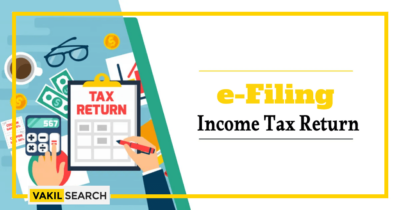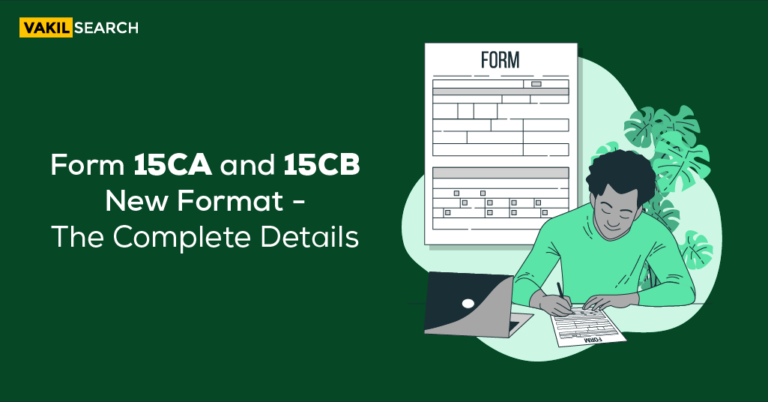Are you working as a sole proprietor and confused about your taxes? This detailed guide explains how you can file sole proprietorship tax returns.
As a sole proprietor, you have to take up a lot of responsibilities. This implies that you will have a lot of work and commitments. When you’re not marketing, you’re either tracking inventory or converting a lead into a customer. You have no time to take care of complex matters like taxes, accounting, and legal compliances because of these obligations. You must occasionally comply with a number of sole proprietorship tax laws and regulations when it comes to taxes. Therefore, keeping track of these forms can be complicated for both experienced and novice sole proprietors. To make things easier, here’s an article that will guide you through the steps for E-filing ITR for small proprietorship business.
What is Sole Proprietorship Taxation?
Businesses with just one owner are known as sole proprietorships, and the owner is responsible for the company’s debts entirely. These companies are not incorporated as distinct legal entities. Start-ups and part-time companies are usually sole proprietorships. The business is not separate in this form, and a sole proprietor is exempt from filing business tax returns as the owner. Instead, business profits and losses must be reported on the owner’s personal tax filings. The taxation for a sole proprietorship in India is the same as that of the individual. Sole proprietors have the option to file sole proprietorship tax returns in accordance with the new slabs from FY 2020–21 onwards, subject to certain criteria, as part of a new tax regime introduced in Budget 2020.
When the sole proprietor is under 60 years of age, the tax rate for sole proprietorships is as follows:
| Taxable Income | Tax Rate |
| Up to ₹2,50,000 | Nil |
| ₹2,50,000 to ₹5,00,000 | 5% |
| ₹5,00,000 to ₹10,00,000 | 20% |
| Above ₹10,00,000 | 30% |
When the sole proprietor is between the ages of 60 and 80, the tax rate for sole proprietorships is as follows:
| Taxable Income | Tax Rate |
| Up to ₹3,00,000 | Nil |
| ₹3,00,000 to ₹5,00,000 | 5% |
| ₹5,00,000 to ₹10,00,000 | 20% |
| Above ₹10,00,000 | 30% |
When the sole proprietor is above 80 years of age, the tax rate for sole proprietorships is as follows:
| Taxable Income | Tax Rate |
| Up to ₹5,00,000 | Nil |
| ₹5,00,000 to ₹10,00,000 | 20% |
| Above ₹10,00,000 | 30% |
Rate of Surcharge: Individuals are required to pay surcharges in addition to income tax at the rates of 10% (if total income exceeds ₹50 lakh but does not exceed ₹1 crore), 15% (if total income exceeds ₹1 crore but does not exceed ₹2 crore), 25% (if total income exceeds ₹2 crore but does not exceed ₹5 crore), and 37% (if total income exceed ₹5 Crore)
Health and Education Cess: Regardless of income, a 4% health and education cess is charged on “income tax and surcharge.”
Rebate Under Section 87A: A resident person may qualify for the rebate provided his annual income does not exceed ₹5,00,000. The reimbursement will be equal to 100% of income tax or ₹12,500, whichever is less.
Uncover tax-saving opportunities – our Income Tax Calculator is your financial ally.
How Can You Fill Out Sole Proprietorship Tax In India?
Steps to file a sole proprietorship tax return is as follows:
- Firstly, apply for a PAN card. The Internal Revenue Service sends this card to each taxpayer. It provides a one-of-a-kind Permanent Account Number (PAN) to the cardholder, which is necessary to pay taxes.
- The proprietor’s PAN must be used to pay taxes and submit returns because a proprietorship lacks a distinct legal entity.
- At the e-filing portal, you must first register yourself. However, if you are already registered, you must log in using your PAN.
- Then choose “Income Tax Return” from the drop-down box under “E-filing” section.
- On this page, you must choose one of the alternatives below: –
- Year of Assessment
- ITR Form
- Type of Filing (Original/Revised)
- In the submission option, select Prepare and Submit.
- Press the enter key to proceed. You must carefully complete all of the information provided on the new page.
- While certain details will be necessary, others may depend on its applicability.
- You must choose a verification method after filling out all of the necessary fields. Two alternatives for filing are electronic, and one is physical. There are three filing options.
- Select e-verify to have the filing immediately validated.
- After 120 days, e-verify your ITR. This will allow you a chance to amend any necessary information.
- Click on “I do not wish to e-verify” to proceed with your filing process.
- From the drop-down list, choose “Preview and Submit.” To double-check any errors, you can preview the return before submitting it.
- Following submission via the e-verify option, you can validate your return using an OTP or an EVC (Electronic Verification Code). The OTP/EVC must be submitted within 60 seconds for successful verification.
Conclusion
It’s important to submit tax returns on time and settle all of your debts by the due date. You risk paying significant fines, penalties, and interest on unpaid taxes if you submit your tax return after the due date. Because it is a busy time of year for their company or because there are problems with the documents needed to complete returns, sole proprietors and other small business owners occasionally struggle to file their tax returns on time. For the majority of sole proprietors, paying taxes on their business profits is a necessary but undesirable component of running a business. There is minimal room for error when dealing with business taxes due to the possibility of fines and interest building up. If you still have doubts regarding how to file taxes as a sole proprietor, Vakilsearch can be your best bet for cost-effective legal advice.
Also, Read:










